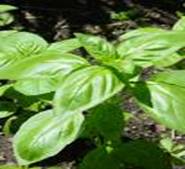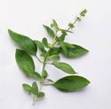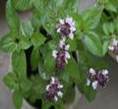Scientific Classification:
|
Other Common Names:
The other common names for the herb basil are Arjaka, Common Basil, French Basil, Garden Basil, Luole, Royal Herb, St. Josephwort, Sweet Basil and Tulsi.
History

Description


Range
Basil was probably originally a native plant from Iran or India. It arrived in Europe via the Middle East in Italy. After this it made its way to the south of France in 15th century, then on to England in the 17th century. It then travelled across the Atlantic to America with the first immigrants. Today, basil plants are particularly found near Italy, and also in France, Morocco and Egypt. There is a similarly large a proliferation of Basil in Asia, central and South America. In the USA the largest quantities are cultivated in the State of California.
Habitat
Basil prefers soil that is light and slightly acidic and it also grows best if the soil is well-drained and nutrient rich having lots of humus and minerals. The basil can tolerate pH ranges starting from 4.3 all the way to pH 8.4 and grows well between these optimum ranges. The basil when growing must be well watered and exposed directly to the sunlight, it is important to avoid water logging in the soil as the plant may die in such conditions. Basil is usually grown in gardens.
Cultivation
Seeds of the basil are sown to a depth of six mm or about one fourths of an inch into the soil. Soil containing the seeds is kept moistened at all times seeds germinate and this watering is carried out for a period lasting about eight to fourteen days at a stretch, water logging is a danger and the soil has to be carefully watered till the seedling break out. The seedling come out and at this time, it is normal to trim the tops of the growing seedlings when they reach about fifteen cm or six inches in height, this trimming is necessary to keep the height of the herb manageable and to encourage the growth and lateral branching in the plant. When the danger of frost is past, the seedling can be transplanted to the well watered and well lit soil out of doors. When transplanting the seedlings, these must be kept spaced apart by 30 to 45 cm or 12 to 18 inches per plant. The basil is not very good at tolerating temperatures below 5°C or 41°F and if the temperatures are too low, the plant may die, for this reason it is important to keep the plants covered with a plastic row cover or using cloches whenever the temperature drops, especially during the night and early morning. To make the plants to continuously give off new leaves, it is necessary to pinch off the flower stalks from time to time - in this way the plant will always be growing. Basil can be grown indoor from seed, seedling or cuttings from vegetable garden plants. Provide direct sunlight and warmth and feed monthly. An underfed basil plant, indoors or out, will have pale green leaves. Flowering Season
The labiate white flowers of basil are in bloom between mid to late summer.
Pests and Diseases
The basil is also quite vulnerable to some plant disease, such as leaf spot disease particularly if the ambient humidity is high such as during rains, the same susceptibility can also affect the plants grown in very poorly drained soils. In addition, one must guard against aphids and thrips which can easily infest the plant. Beetles and slugs can be a nuisance outdoors, tearing holes in the leaves.
Parts Used
  |
The leaves, flowering tops and essential oil are the most commonly used parts of basil for its medicinal and commercial purposes. |
Medicinal Application


- Basil is used to aid relief from colds, influenza, stomach cramps, nausea, migraine, insomnia, low spirits and exhaustion.
- Sweet basil are used mainly for the treatment of different disorders of the digestive and the nervous systems,
- It is also used for the treatment of colic, and to treat cases of indigestion affecting people.
- The remedies derived from the sweet basil are also used to treat intestinal worms in people affected by such parasites.
- The mildly sedative action of the sweet basil is used in the treatment of long term nervous irritability, physical tiredness, and symptoms of depression, long term and short term anxiety and to treat insomnia in different individuals.
- The herbal remedies made from the sweet basil have also been used in the treatment of disorders such as epilepsy, migraine whooping cough in children.
- Basil helps in inducing lactation in nursing mothers.
- The sweet basil herb is also used as a topical remedy for external application in the treatment of various skin disorders, insect bites, acne and ringworm.
- It is used as a gargle or mouthwash for thrush; as a bath herb for increased energy; and as eyewash for tired eyes.
Commercial and Culinary Applications

- Basil compliments most dishes as it combines well with so many different types of ingredients from carrots to potatoes to veal.
- It is said that the leaves of basil can be crushed and massaged into the scalp to stimulate hair growth.
- Tribes believe basil will encourage a good night's rest if the basil plant is put underneath the pillow.
- Basil will deter flies where and the dried stalks of basil can be burnt on the fire to repel midges and mosquitoes.
- For a revitalizing bath, add some basil, lie back and enjoy.
- Dried seed heads of basil are added to pot pori.
Religious Influence
It is believed to have grown in the same spot that Helen and St. Constantine found the Holy Cross. This is the reason that it is now being used in the preparation of the holy water in Greek Orthodox Churches. Pots of basil are kept around the alter for their religious healing that the Greeks believe will take place. Basil was also used by the Greek and English royalty for their baths, and medicine. Hence why the word basil is still referred to as "the king of herbs" from world-renowned chefs. In India where it grew originally, it was held in great admiration and was actually used in courtrooms to have the Indians swear their oaths upon. In Italy however, basil symbolizes love.
Folklore and Myths
Basil was once considered to belong to the Devil and was used in a remedy against witches. When an Italian suitor wanted to show his love he would place a sprig of basil in his hair to win his hearts desire. It is the same in Mexico where people would keep basil in their pockets in hopes that the man or woman that they loved would return their love forever. In Romanina, they followed much of the same legend, where the man would give basil to his love and they would officially be engaged. In ancient Rome basil has also long been revered. They called it Basilescus, which refers to the Basilisk, the fire-breathing dragon. As legend says, if you took basil every day then it would ward off attacks from the beast.


